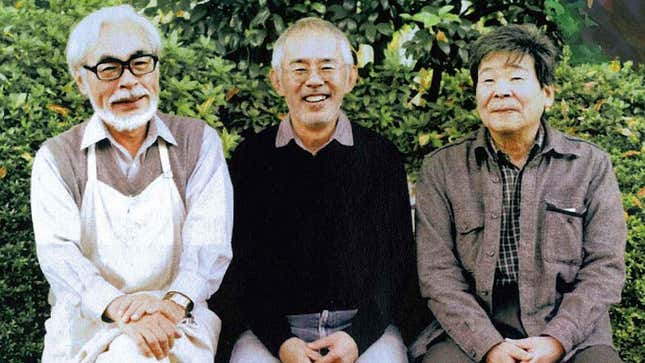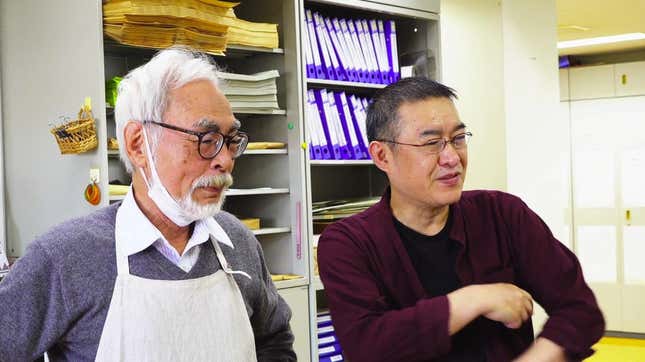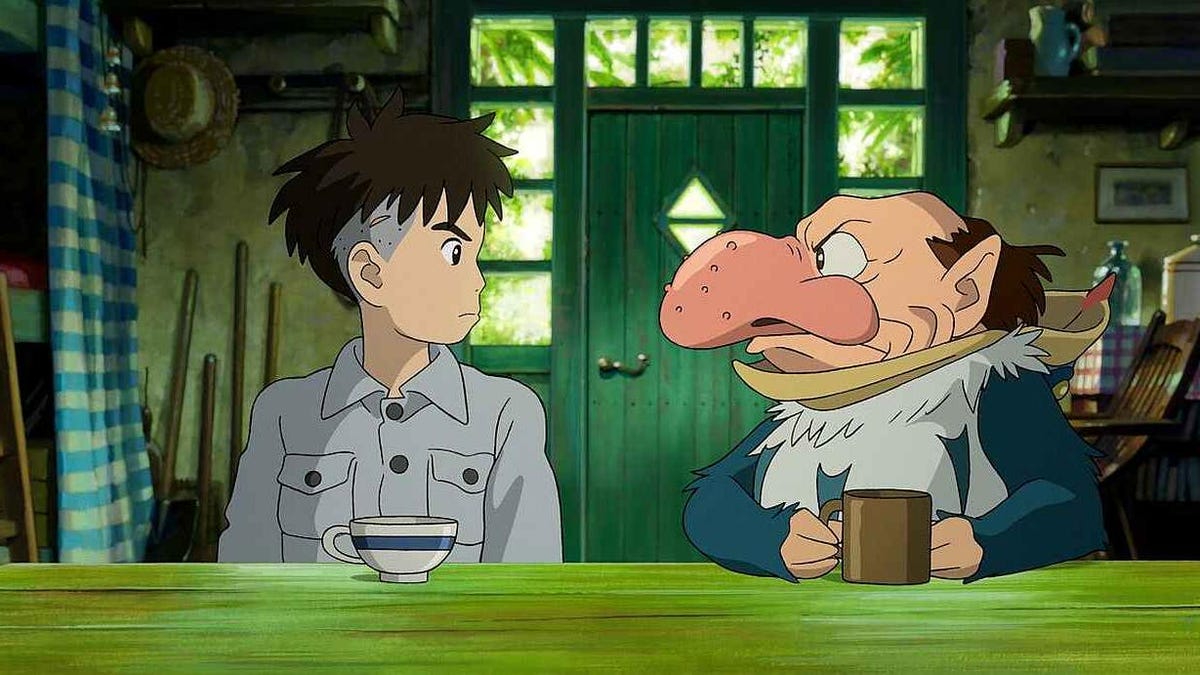The Boy and the Heron is legendary director Hayao Miyazaki’s masterpiece. The 2023 Studio Ghibli film is a triumphant work of art that revisits and interrogates every theme Miyazaki has spent his lengthy career digging into across numerous animated features that have become classics across the globe. Now a companion piece to the film, a documentary called Hayao Miyazaki and the Heron, is available to stream on Max, and it’s an impressive feat in its own right. As it chronicles the animated feature’s production, the doc reflects that film’s interrogative spirit, examining the past and future of both Studio Ghibli and Miyazaki himself.
The Boy and the Heron, as Hayao Miyazaki explains in the documentary, is not a film about his own creative legacy. It is a story about the death of Isao Takahata: one of Ghibli’s founders, director of Grave of the Fireflies and The Tale of the Princess Kaguya, and “longtime ally, rival, and friend” of Miyazaki’s. But although Takahata died in 2018, our documentary begins five years earlier, with Miyazaki’s promise that he is retiring—for real this time—after the release of The Wind Rises.
Hindsight being what it is, we know the director comes out of retirement, bringing the initial idea for what would become The Boy and the Heron to longtime producer Toshio Suzuki in 2016. But Takahata’s death ends up engulfing Miyazaki in production, and though the idea preceded his passing, The Boy and the Heron is ultimately a product of Miyazaki working through the grief of that loss. That is, if he is to be believed.

Miyazaki certainly seems unmoored by the loss of his friend. For instance, during Takahata’s memorial service, he relays an anecdote about the two of them sharing a moment at a bus stop in the rain. Producer Suzuki, however, confesses that he doubts the moment ever happened, suggesting that Miyazaki is getting reality confused with images from his own films, in this case a famous moment from My Neighbor Totoro.
The documentary emphasizes this blending of fact and fiction, with frequent shots from Studio Ghibli’s collection of iconic works being spliced throughout. During Miyazaki’s story about Takahata, for instance, the film suddenly jumps to that iconic shot in Totoro. It’s an editing trick used to great effect, in how it unmoors the audience from reality in the same way Miyazaki—and all artists to some extent—constantly walk between the real and imagined worlds within their minds.
The director copes with his grief the only way he knows how—by writing. He further skirts the line between realities by casting those around him, alive and dead, as the characters in The Boy and the Heron. Producer Suzuki, whom Miyazaki describes as a con-man, is the trickster heron, and the documentary flips between shots of both cackling deviously. Dearly departed Takahata is the mysterious old Granduncle, and Miyazaki himself is Mahito, the film’s protagonist. More shots intercutting the real people with the animated counterparts Miyazaki has paired them with in his mind give us a glimpse into the madness of the method.
Isao Takahata isn’t the first or last death we see Miyazaki dealing with during the making of The Boy and the Heron. It’s a production unfortunately filled with the passing of people close to Miyazaki, and each death hits the director hard, adding new dimensions to The Boy and the Heron’s own themes of grief and acceptance. With each loss Miyazaki and Studio Ghibli must endure, he, like Mahito, is increasingly filled with anger toward the world for taking those around him. But Takahata’s death haunts Miyazak the most. He thinks of the departed director as the only person who ever “got” him as a fellow creator, and now that he’s gone, he sees him in everything from a lost eraser to a lightning storm. The documentary continuously cuts back to the departed director cycling down a road and around the corner, just out of reach. And watching, you come to understand Miyazaki’s perception of the world—and of The Boy and The Heron–thanks to this incredible documentarian work.
But Miyazaki’s narrative isn’t the only one that exists. Hayao Miyazaki and the Heron has its own perspective, highlighting a filmmaker who seems more taken with life than death throughout the film’s process. In The Kingdom of Dreams and Madness, an earlier Ghibli documentary made before the death of Takahata, Miyazaki is more nonchalant about the prospect of death and the fate of Ghibli should he pass on, at one point laughing when asked about the studio’s future, responding that the future is clear. “It’s going to fall apart. I can already see it.” During production of The Boy and the Heron, however, the director reiterates his desire to continue living and creating despite the cloud of death around him. He’s preoccupied with Ghibli’s legacy. Clips of past films worm their way into his head as often as they do in this film, as they represent not just his life’s work, but also Takahata’s and that of countless others. He wants there to be a next generation that can take up the pencil.
Enter Takeshi Honda, known for his work as a character designer and animation director on the Rebuild of Evangelion films. Brought on as The Boy and the Heron’s supervising animator, Honda is of a younger generation, as Miyazaki likes to put it, being at the spry age of 56 while Miyazaki is 83 (in 2024). His new ways of doing things irk the director immediately, despite the evident skill of the newcomer. Over the course of production, however, Miyazaki finds a new friendly rivalry in the form of Honda’s presence. The collaborative, and sometimes combative, relationship has hints of Miyazaki’s dynamic with Takahata. Maybe there are other creators out there that can understand Miyazaki, and— just maybe—Honda is one of them. But the old man is doubtful.
Miyazaki has always been a perfectionist. In the past we’ve seen him labor over animations for days to get them right as only he can, such as with the intricate planes he became obsessed with during production of The Wind Rises. So many shots in Hayao Miyazaki and the Heron show the director throwing away the efforts of others, and sometimes his own lesser tries. But when faced with a particularly difficult shot, in which Mahito strolls through a passageway near the end of the film, Miyazaki and Honda come face to face yet again. We see the director pick up Honda’s version, as we have many times, with his own in hand ready to replace it. But Miyazaki looks at Honda’s work, in which the younger animator shows Mahito fade through the camera itself, and he can’t help but see the incredible talent on display. Miyazki tosses his own version in the bin. Honda’s rendition of the scene remains one of the most subtly stunning moments in the final version of The Boy and the Heron.

Miyazaki may see himself as Mahito, but at this moment, as in many others, the documentary suggests he may be more like the animated film’s Granduncle. Desperately searching for a sign that the next generation can create something for the future, something new that doesn’t just emulate his own work, but pushes beyond it. That creative drive would be a true fulfillment of his, Takahata’s, and Ghibli’s legacy. In his relationship with Honda he seems to find a glimmer of it.
The truth behind The Boy and The Heron lies somewhere between both Miyazaki and the documentary’s perspective. He isn’t solely Mahito or Granduncle; he is both at once. In fact, he is everyone in The Boy and the Heron in some way. The con-man heron that convinces Mahito to go on this journey is also Miyazaki convincing himself to make yet another film. Each character from every Ghibli film that started in Miyazaki’s mind bears some shard of him. The director himself says that to make these works of art, he must open his brain to the world. The Boy and the Heron is a masterful work in which Miyazaki lays himself bare to the world in a way he has never done before. No wonder the documentary opens with a shot of the director naked in an onsen.
Despite being obsessed with the death taking place around him, and joking about his own inevitable demise, Miyazaki lives. The end of The Wind Rises, which was once going to be the director’s final film, ends with the simple command to live. The Boy and the Heron’s Japanese title, How Do You Live? responds to that command with a question. Hayao Miyazaki and the Heron answers that question. “If we don’t create, there’s nothing,” says the director. So Hayao Miyazaki creates.
The Boy and the Heron and Hayao Miyazaki and the Heron are now available to stream on Max.
.

